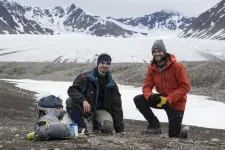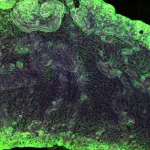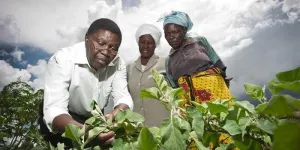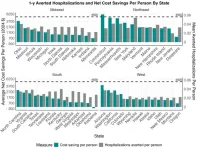(Press-News.org) Melting Arctic glaciers are in rapid recession, and microscopic organisms colonise the newly exposed landscapes. Dr. James Bradley, Honorary Reader in Arctic Biogeochemistry in the School of Biological and Behavioural Sciences at Queen Mary University of London, and his team, have revealed that yeasts play an important role in soil formation in the Arctic after glaciers have melted away.
Roughly 10% of Earth’s land surface is covered by glacial ice. However, glaciers are retreating ever further and ever faster because of global warming. As they do, they expose new landscapes which, for many thousands of years, have been covered in ice. After the glacial ice is gone, microscopic lifeforms colonise the now accessible bedrock, accumulating nutrients and forming new soils and ecosystems. As soil can be a significant carbon store under the right circumstances, how exactly new soils form after the melting of glaciers is a question of great scientific and societal relevance.
To study the formation of Arctic soils, a team led by Dr. Bradley travelled to Svalbard – an archipelago of islands roughly halfway between the North Pole and Norway's northern coast, and well above the Arctic circle. Here, the climate is warming seven times faster than the rest of the world, and glaciers are in rapid decline. The barren landscapes that are exposed offer very little to support any form of life: the rocky terrain is lacking nutrients, temperatures drop to well below freezing for months on end, and because of its high latitude, there is a complete lack of sunlight during the winter polar night. The very first pioneer colonisers of the inhospitable terrain are microorganisms such as bacteria and fungi. These microbes determine how much carbon and nitrogen can be stored in the soils – but very little is known about the exact processes behind this nutrient stabilisation through microbial activity. Bradley and his team studied these soils to better understand how microbes contribute to the process of soil formation when glaciers vanish. The results of the study, in which other researchers from Germany, the United States, and Switzerland were involved, have now been published in the journal Proceedings of the National Academy of Sciences (PNAS). The research was funded by the UK Natural Environment Research Council (NERC), the US National Science Foundation (NSF), and the German National Science Foundation (DFG).
Timeline of colonisation
The research focusses on the forefield of Midtre Lovénbreen, a retreating valley glacier in the northwest of Spitsbergen. Dr. James Bradley, who first worked at the site in 2013, said: “A decade ago I was walking on top of the ice and drilling ice cores into the glacier. When we returned in 2021, the glacier had shrunk and instead of ice there were barren, seemingly lifeless soils”. But upon laboratory-based analyses of these soils, the researchers found that they contain incredibly diverse communities of microbes, the smallest and simplest forms of life on Earth.
The newly exposed areas are ideal for researching incremental changes in the soil as they are a natural laboratory for observing the various stages of soil development. The soil closer to the glacier margin is the youngest, and soil further away from the retreating glacier is incrementally older – where more time has passed allowing life to colonise the terrain. “These are some of the most pristine, delicate, and vulnerable ecosystems on the planet, and they are rapidly colonised by specialised microbes, even though they are subject to extremes in temperature, light, water and nutrient availability” said Dr. Bradley.
Adjusting to the midnight sun and the often changeable weather, the scientists spent weeks working on the rocky and uneven terrain of the glacier forefield, surrounded by crevassed ice, a fjord home to minke whales and seals, and tundra shared by Arctic foxes, reindeer and polar bears. The researchers are trained in recognising polar bear behaviours and safe handling of firearms, in case of an encounter with a bear while working in the remote Arctic environment.
Pioneer fungi sequester carbon in the soil
Bradley’s team investigated the microbial composition of the soils by DNA analysis, while also measuring the cycling and flow of carbon and nitrogen. Through experiments involving isotope labeled amino acids, they were able to precisely follow the microbial assimilation and metabolism of organic carbon. “We were especially interested in what proportion of carbon microorganisms lock in the soil as biomass and how much they release back into the atmosphere as carbon dioxide,” says Juan Carlos Trejos-Espeleta, the lead author of the study from Ludwig Maximilian University of Munich, Germany.
Their main focus was on fungi – a group of microorganisms that are known to be often better adapted than bacteria at storing a lot of carbon in the soil and keeping it there. The ratio of fungi to bacteria is an important indicator of carbon storage: More fungi mean more carbon in the soil, while more bacteria generally lead to the soil emitting more CO2. “In high Arctic ecosystems, the variety of fungi is particularly high compared to that of plants, which increases the likelihood that fungal communities could play a key role there as ecosystem engineers,” said author Professor William Orsi, from Ludwig Maximilian University of Munich, Germany. Discovering more about the carbon assimilation processes of fungal and bacterial populations and carbon flow processes in the ecosystem is crucial for making accurate predictions about how terrestrial ecosystems in the Arctic will respond to future warming.
And indeed, the researchers were able to show that fungi – or more precisely, specific basidiomycete yeasts – play a decisive role in the early stabilisation of the assimilated carbon. According to the study, they are the fungal pioneers in the young postglacial soils and make a decisive contribution to the enrichment of organic carbon. “We found that these specialised fungi are not only able to colonise the harsh Arctic landscapes before any other more complex life, but that they also provide a foothold for soil to develop by building up a base of organic carbon which other life can use” said Dr. Bradley. In older, bacteria increasingly dominate amino acid assimilation, leading to a significant reduction in the formation of biomass and an increase in CO2 emissions from respiration. “Our results demonstrate that fungi will play a critical role in future carbon storage in Arctic soils as glaciers shrink further and more of Earth’s surface area is covered by soil” summarises Prof. Orsi.
END
Shrinking glaciers: Microscopic fungi enhance soil carbon storage in new landscapes created by shrinking Arctic glaciers
2024-07-01
ELSE PRESS RELEASES FROM THIS DATE:
UMD-led study finds one-third of Indonesia’s deforested land left idle
2024-07-01
EMBARGOED UNTIL JULY 1, 2024 AT 3:00 PM U.S. EASTERN TIME
According to a new study published in the Proceedings of the National Academy of Sciences, extensive land areas have been left sitting idle after tropical forests were cleared in Indonesia, a country renowned for its biodiverse rainforests and carbon-rich peatlands. Since 1990, the country has lost 25% of its old-growth forest, and while over one-quarter (7.8 million hectares) of Indonesia’s deforested lands have been converted to palm oil plantations since ...
University of Cincinnati study: Overlooked brain organ plays key role in promoting brain repair after stroke
2024-07-01
University of Cincinnati researchers have pioneered an animal model that sheds light on the role an understudied organ in the brain has in repairing damage caused by stroke.
The research, published July 5 in the Proceedings of the National Academy of Sciences, sought to learn more about how the adult brain generates new neurons to repair damaged tissue.
The research team focused on the choroid plexus, a small organ within brain ventricles that produces the brain’s cerebrospinal fluid (CSF). CSF circulates throughout the brain, carrying signaling molecules and other factors thought to be important for maintaining brain function. However, prior to this study, little ...
Harvard researchers find that gratitude is a useful emotional tool in reducing desire to smoke
2024-07-01
Smoking continues to rank as the foremost preventable cause of premature death. In a paper published this week in the Proceedings of the National Academy of Science (PNAS), Harvard researchers report findings that evoking feelings of gratitude in people who smoke helps reduce their urge to smoke, and increases their likelihood of enrollment in a smoking cessation program. They note that these findings could inform newer approaches to public health messaging campaigns that aim to reduce so-called “appetitive” risk behaviors like smoking, drinking, and drug use.
The research team built on the Appraisal Tendency Framework, a theoretical model of emotiona and decision making, ...
Researchers disclose the effect of social media use on the mental health of college students during the pandemic
2024-07-01
The COVID-19 pandemic had an unprecedented effect on college students’ mental health: symptoms like anxiety and major depression in young adults ages 18-25 increased significantly compared to before the pandemic.
A new study from researchers at the University of North Carolina at Chapel Hill looks at a possible contributing factor to the worsening trends in mental health: social media.
We know that college students and adolescents are using social media more. Last May, the US Surgeon General issued an advisory on social media and youth mental ...
July Issues of APA Journals cover new research on pharmacogenomics, ADHD medication use, associations between mental health and cardiometabolic complications later in life, and more
2024-07-01
WASHINGTON, D.C., July 1, 2024 — The latest issues of four American Psychiatric Association journals, The American Journal of Psychiatry, Psychiatric Services, American Journal of Psychotherapy and Psychiatric Research and Clinical Practice are now available online.
The July issue of The American Journal of Psychiatry brings together research on affective disorders, pharmacogenomics, and psychiatric illness-related cardiometabolic problems. Highlights include:
• Genome-Wide Association Study of Treatment-Resistant Depression: Shared Biology With Metabolic Traits.
• Pharmacogenomic Clinical ...
Most climate-vulnerable countries with highest hunger rates significantly under-represented in agrifood research
2024-07-01
The most climate-vulnerable countries with the highest hunger rates are significantly under-represented in agrifood research – sparking a need for urgent action and increased investments to redress this imbalance, a major new study has found.
The ‘State of the Field for Research on Agrifood Systems’ report, published by The Juno Evidence Alliance – a partnership of CABI, Havos.Ai and the University of Notre Dame, USA – found that only one out of eight research papers is led by scientists from ...
UMD researchers develop new and improved camera inspired by the human eye
2024-07-01
A team led by University of Maryland computer scientists invented a camera mechanism that improves how robots see and react to the world around them. Inspired by how the human eye works, their innovative camera system mimics the tiny involuntary movements used by the eye to maintain clear and stable vision over time. The team’s prototyping and testing of the camera—called the Artificial Microsaccade-Enhanced Event Camera (AMI-EV)—was detailed in a paper published in the journal Science Robotics in May 2024.
“Event cameras are a relatively new technology better at tracking ...
Self-assembling, highly conductive sensors could improve wearable devices
2024-07-01
UNIVERSITY PARK, Pa. — To advance soft robotics, skin-integrated electronics and biomedical devices, researchers at Penn State have developed a 3D-printed material that is soft and stretchable — traits needed for matching the properties of tissues and organs — and that self-assembles. Their approach employs a process that eliminates many drawbacks of previous fabrication methods, such as less conductivity or device failure, the team said.
They published their results in Advanced Materials.
“People have been developing soft and stretchable conductors for almost a decade, but the conductivity ...
Lab values predict periprosthetic joint infection in patients with morbid obesity
2024-07-01
Waltham — July 1, 2024 — For patients with severe obesity undergoing knee or hip replacement, commonly obtained laboratory values – including markers of anemia and inflammation – are independent predictors of the risk of periprosthetic joint infection (PJI), reports a study in The Journal of Bone & Joint Surgery. The journal is published in the Lippincott portfolio by Wolters Kluwer.
Hemoglobin level, platelet count, and several markers of systemic inflammation may be relevant to the elevated ...
Study suggests states could cut healthcare costs by delivering patient tailored meals
2024-07-01
Chicago (July 1, 2024) — According to new research looking at every U.S. state, programs that deliver medically tailored meals (MTMs) to people with diet-sensitive conditions such as diabetes and heart disease along with limitations in the ability to perform daily activities could lead to substantial savings in healthcare costs. Using computer models to estimate the benefits of such programs minus the expense of implementing them, researchers found significant variation between U.S. states but an overall net cost savings in almost every state.
“By ...






